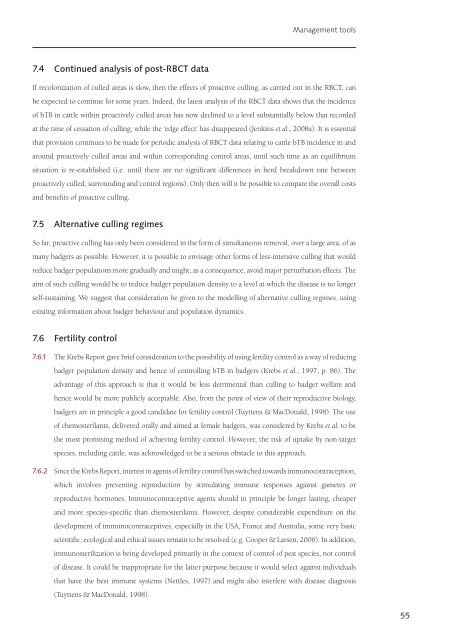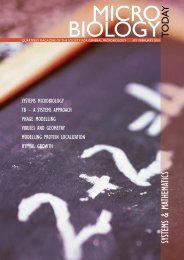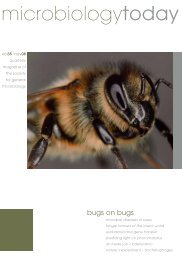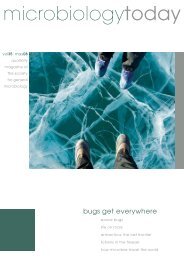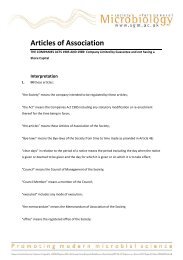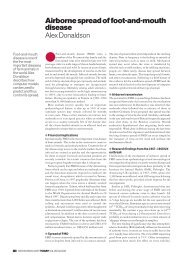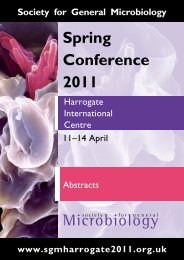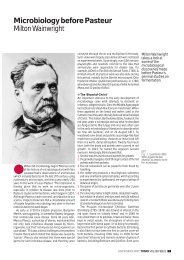final report - ARCHIVE: Defra
final report - ARCHIVE: Defra
final report - ARCHIVE: Defra
Create successful ePaper yourself
Turn your PDF publications into a flip-book with our unique Google optimized e-Paper software.
Management tools<br />
7.4 Continued analysis of post-RBCT data<br />
If recolonization of culled areas is slow, then the effects of proactive culling, as carried out in the RBCT, can<br />
be expected to continue for some years. Indeed, the latest analysis of the RBCT data shows that the incidence<br />
of bTB in cattle within proactively culled areas has now declined to a level substantially below that recorded<br />
at the time of cessation of culling, while the ‘edge effect’ has disappeared (Jenkins et al., 2008a). It is essential<br />
that provision continues to be made for periodic analysis of RBCT data relating to cattle bTB incidence in and<br />
around proactively culled areas and within corresponding control areas, until such time as an equilibrium<br />
situation is re-established (i.e. until there are no significant differences in herd breakdown rate between<br />
proactively culled, surrounding and control regions). Only then will it be possible to compare the overall costs<br />
and benefits of proactive culling.<br />
7.5 Alternative culling regimes<br />
So far, proactive culling has only been considered in the form of simultaneous removal, over a large area, of as<br />
many badgers as possible. However, it is possible to envisage other forms of less-intensive culling that would<br />
reduce badger populations more gradually and might, as a consequence, avoid major perturbation effects. The<br />
aim of such culling would be to reduce badger population density to a level at which the disease is no longer<br />
self-sustaining. We suggest that consideration be given to the modelling of alternative culling regimes, using<br />
existing information about badger behaviour and population dynamics.<br />
7.6 Fertility control<br />
7.6.1 The Krebs Report gave brief consideration to the possibility of using fertility control as a way of reducing<br />
badger population density and hence of controlling bTB in badgers (Krebs et al., 1997, p. 86). The<br />
advantage of this approach is that it would be less detrimental than culling to badger welfare and<br />
hence would be more publicly acceptable. Also, from the point of view of their reproductive biology,<br />
badgers are in principle a good candidate for fertility control (Tuyttens & MacDonald, 1998). The use<br />
of chemosterilants, delivered orally and aimed at female badgers, was considered by Krebs et al. to be<br />
the most promising method of achieving fertility control. However, the risk of uptake by non-target<br />
species, including cattle, was acknowledged to be a serious obstacle to this approach.<br />
7.6.2 Since the Krebs Report, interest in agents of fertility control has switched towards immunocontraception,<br />
which involves preventing reproduction by stimulating immune responses against gametes or<br />
reproductive hormones. Immunocontraceptive agents should in principle be longer lasting, cheaper<br />
and more species-specific than chemosterilants. However, despite considerable expenditure on the<br />
development of immunocontraceptives, especially in the USA, France and Australia, some very basic<br />
scientific, ecological and ethical issues remain to be resolved (e.g. Cooper & Larsen, 2006). In addition,<br />
immunosterilization is being developed primarily in the context of control of pest species, not control<br />
of disease. It could be inappropriate for the latter purpose because it would select against individuals<br />
that have the best immune systems (Nettles, 1997) and might also interfere with disease diagnosis<br />
(Tuyttens & MacDonald, 1998).<br />
55


